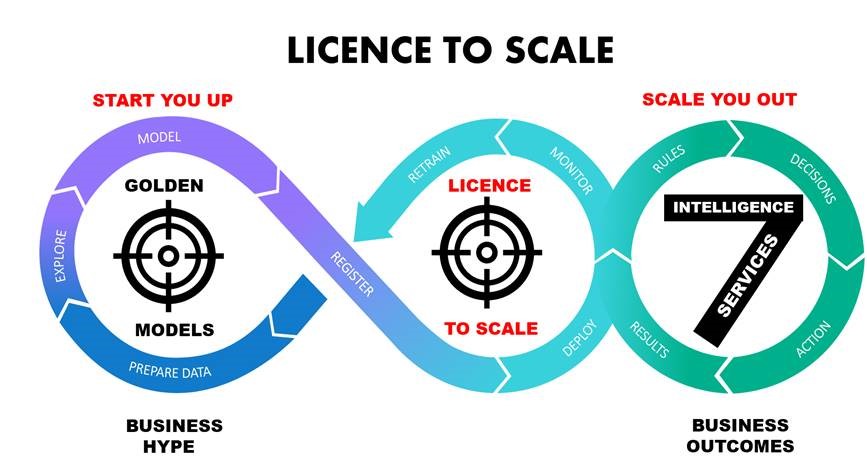Data, AI and digital transformation will define the industry of the future. The die is cast. Without an industrial approach for analytics, there will be no future!
Diamonds are forever
Khepri, a deity of ancient Egypt, symbolized the morning rebirth of the sun. Khepri is also said to have inspired the logo of a century-old car brand. This was the go-to car for the world’s most famous MI6 secret agent – who undoubtedly didn't only live twice.
Unless decision makers and doctors again say “No,” this logo should once again see the light of day on racing circuits and our screens, for our eyes only, as soon as the health situation improves. Diamonds are forever, unless:
Live and let die
In the automotive industry, as in many other sectors, contemporary economic history shows that brands sometimes hold up better than the companies that own and run them. Hesitating between living and letting die, between sovereignty and dependence, the European industrial landscape and its ecosystems have been reshaped and sometimes weakened by economic cycles and crises. They leave in their wake a funeral procession of bankruptcies, mergers, acquisitions, dismantling and relocations.
The latest “spectre” to date – the health crisis that has affected both supply and demand – has directly affected more than 75% of the world’s manufacturers. This resulted in critical disruptions in production and supply chains. The social and economic consequences exacerbated the fragility of traditional industry stakeholders and the formidable resilience of digital companies.
Deindustrialization has shown that the world is not enough and paralyzed the economic fabric of many countries. In France, stagnating GDP from the secondary industrial sector is particularly alarming, with the flagships of the French economy (tourism, luxury goods, aeronautics, etc.) struggling. Pulled into a spiral of deindustrialization for decades, manufacturers must now face the facts their living daylights depend on.
Tomorrow never dies
In this unprecedented context, the “normal” world is no longer enough to satisfy the appetite for growth. Without an energy transition and digital transformation, there seems to be no way out. Industry must reinvent itself to adapt the production system and its ecosystems to an economic environment that will never, say never, be the same again. It must accelerate the transformation towards a more sustainable, more digital and perhaps more local industry of the future. It is a matter of survival. Tomorrow never dies, except for some.
Die another day
Digital transformation is no longer an option. Many manufacturers have already invested heavily in this area, particularly in data processing, analytics and artificial intelligence. This massive pillar of the industry of the future is of particular interest to us here.
However, a recent study by Accenture shows that, across all sectors, more than 80% of projects fail at the experimental stage and do not provide the expected return on investment. Only 15% of companies manage to achieve this milestone and generate an initial return on investment on the use cases implemented. A fraction of them – fewer than 5% – succeed in scaling up. They do this by defining analytical approaches and operating models that truly fit the company’s objectives, strategy and business model.
On a case-by-case basis, explanations abound for these multiple failures. The same explanations ring true in several economic sectors, while others are more specific to manufacturing. There is now an urgent need to get to the bottom of it all and start providing solutions.
On her data’s secret service
Sometimes initiated in secret, sometimes with a lot of fanfare, these experiments are too often guided by the latest technology trends. And every so often they forget their whole purpose: long-term business benefits and positive human, cultural and organizational impact.
In industry, the main marker is crystallized in the duality between IT – or information technologies guided by transactions (ERP, CRM, etc.) and the loT – and operational technologies focused on industrial processes (MES, SCADA, etc.). These technological divides often reflect multiple organizational silos.
Companies never really deploy countless analytical models. Or they deploy them several months too late when the operational conditions no longer correspond to the initial needs.
An industrial analytical platform needs to decompartmentalize and ensure continuity between these two worlds. From analyzing basic data from a sensor to recommending action, or making a real-time decision at the heart of the business process, continuity means close, agile and above all interdisciplinary (IT, business) collaboration throughout the application life cycle.
The man with the golden gun
From the human resources perspective, we have also too often relied unilaterally on technological expertise alone by placing the hyper-specialists of data science on a pedestal: these men with golden guns, these “moonrakers,” who are certainly capable of reaching the moon (as they have proven in the past). But their expertise diminishes when they evolve into weightlessness. They float off the ground, disconnected from the realities of the industrial processes they are analyzing.
State-of-the-art algorithms and flawless modeling do not guarantee the success of an analytical application. The latter will remain grounded at the pilot or proof-of-concept stage if its adoption criteria – and, in particular, its deployment and scale-up – have not been thoroughly thought through beforehand and if the analytical platform has not been designed with this in mind. This is the cost of operational excellence.
Analytical models must be efficient. Organizations must also disseminate them in industrial processes and calibrate them continuously by integrating their constraints (optimization, business rules or human aspects). And above all you must reevaluate or even question them when the conditions of their performance have changed. The impacts of the health crisis on the global supply chain have shown the importance and need for such governance.
No time to die
From R&D to design, experimentation, manufacturing, distribution and consumption, but also recycling, the principles of analytical processes are not very different from industrial principles. From the design office to the final consumer, from the factory to the recycling plant, analytical value chains must now reflect industrial value chains and share their principles of quality (including perceived quality), efficiency, reliability and robustness, but also resilience. The die is cast and the time for experimentation is over. It's no time to die.
Learn more about analytics helping manufacturers accelerate the digital transformation.



